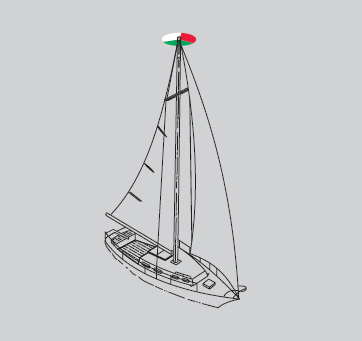Difference between revisions of "Tricolor light"
(changed the arc of the white light sector from 225 to 135.) |
|||
| (3 intermediate revisions by 2 users not shown) | |||
| Line 1: | Line 1: | ||
On sailboats, it is permitted to display a single three-color light fixture at the top of the mast in lieu of the normally required [[sidelights]] and [[sternlight]]. | On sailboats, it is permitted to display a single three-color light fixture at the top of the mast in lieu of the normally required [[sidelights]] and [[sternlight]]. | ||
| − | + | [[Image:Tricolor.png]] | |
| − | The advantage of this light is that a single bulb can be used for all the required navigation lights when sailing at night. This decreases the amount of power needed from the ship's batteries. Another advantage is that the light is higher above the water and potentially more visible from a long distance. | + | This fixture must shine red over an arc of 112.5 degrees from directly forward to port (replacing the port sidelight). The fixture must shine green over an arc of 112.5 from directly forward to starboard (replacing the starboard sidelight). And it must shine white to aft, over an arc of 135 degrees (replacing the sternlight). |
| + | |||
| + | The advantage of this light is that a single bulb can be used for all the required navigation lights when sailing at night. This decreases the amount of power needed from the ship's batteries. Another advantage is that the light is higher above the water and potentially more visible from a long distance. | ||
| + | |||
| + | A possible disadvantage of using the tricolor light while sailing is that -- being much higher than the sidelights and sternlight it replaces -- other craft, especially smaller boats motoring or sailing nearby -- may not notice the tricolor at the top of the mast. So one might consider using the tricolor out to sea, while using the lower lights in harbors, even though either (but not both simultaneously) are legal anywhere. | ||
| + | |||
| + | And one operational complication is that -- since the tricolor cannot replace the lower sidelights and sternlight while motoring -- the crew must remember to turn the tricolor OFF when the masthead light (steaming light) is turned ON when motoring at night. | ||
| + | |||
| + | [[Category:Sailing Terms]] | ||
Latest revision as of 08:56, 14 October 2024
On sailboats, it is permitted to display a single three-color light fixture at the top of the mast in lieu of the normally required sidelights and sternlight.
This fixture must shine red over an arc of 112.5 degrees from directly forward to port (replacing the port sidelight). The fixture must shine green over an arc of 112.5 from directly forward to starboard (replacing the starboard sidelight). And it must shine white to aft, over an arc of 135 degrees (replacing the sternlight).
The advantage of this light is that a single bulb can be used for all the required navigation lights when sailing at night. This decreases the amount of power needed from the ship's batteries. Another advantage is that the light is higher above the water and potentially more visible from a long distance.
A possible disadvantage of using the tricolor light while sailing is that -- being much higher than the sidelights and sternlight it replaces -- other craft, especially smaller boats motoring or sailing nearby -- may not notice the tricolor at the top of the mast. So one might consider using the tricolor out to sea, while using the lower lights in harbors, even though either (but not both simultaneously) are legal anywhere.
And one operational complication is that -- since the tricolor cannot replace the lower sidelights and sternlight while motoring -- the crew must remember to turn the tricolor OFF when the masthead light (steaming light) is turned ON when motoring at night.
